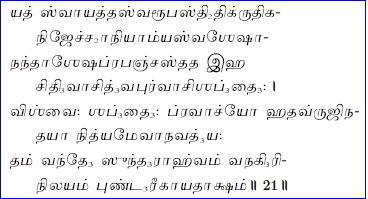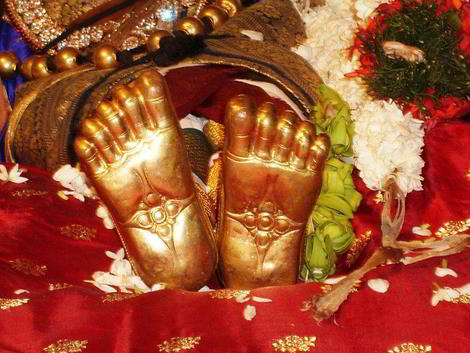- SlOkam 19:
- SlOkam 20:
- SlOkam 21:
pratyagAtmani kadApyasambhavad
bhUmabhUmim abhivakti yamm Sruti: |
tamm vanAdri nilayam susundaram
sundarAyata bujam bhajAmahE ||
Meaning:
We offer our salutations to the Lord with the beautiful arms (Sundara Baahu), who is beautiful (Susundaram) in every way and resides in ThirumAlirum chOlai (VanAdri nilayam bhajAmahE). He is the Lord, who is Bhuma GuNa Visishtan (One who possesses the Vaibhavam that is not possessed by the Jeevans).
The BhUma VidhyA of ChAndhOgya Upanishad is referred to by KuResar Here.The BhUma VidhyA points out that ParamAthmA is distinctly different fromJeevAthma even in its state of Mukthi. For instance ParamAthmA alone (NOTJeevAthma) can grant Moksham; ParamAthmA alone can be established in HisMahimai (SvE mahimnE prathishDitha:) . Our Lord alone can be present insideall jeevans (SarvAthmakathvam). That Lord (Para Brahman), the BhUmAvisishtan is blessing us with His sEvai as Lord Sundara Baahu at
ThirumAlirumchOlai.
KurEsar helped AchArya RaamAnujA write his magnum opus, SrI BhAshyam. He was naturally conversant with all aspects of Sri BhAshyam. In this context, KurEsar composed the 17th slOkam of Sundara Baahu Stavamto summarize JyOthiradhikaraNam of SrI BhAshyam. In the 16th slOkam(gatisAmya labdha), the reference was to Yeekshathya adhikaraNam. The 18thslOkam referred to AntharyAmadhikaraNam. In the 19th slOkam,BhUmAdhikaraNa vishaya vAkya sOdhanam (examination of the meaning ofBhUmAdhikaraNam) becomes the focus.
vandEya sundarabhujam bhujagEndra bhOgasaktam
mahAvanagiri praNaya praveeNam |
yamm tamm vidu: daram ashTaguNOpajushTam
aakAsam aupanishadeeshu sarasvateeshu ||
Meaning:
This slOkam summarizes the Dahara Vidhyai of ChAndhOgya Upanishad.Theessence of this Vidhya is: “This body is a fit place for the residence ofBrahman and hence it is appropriately recognized as Brahmapuram. In thissareeram, ParamAthmA resides always in a small place (daharAkAsam) insidethe heart lotus (Hrudhaya Kamalam). He has limitless auspicious attributes. Onehas to comprehend these anantha kalyANa guNams of the Lord and meditate onHim”. The supreme JyOthi of the Lord and His anantha kalyANa guNams arenot affected even by one iota in spite of His residence in that small place insidethe heart lotus. Out of His great vaathsalyam for the Jeevan, He resides thereand comes to the rescue of the Jeevan. Sri BhAshyam’s AakAsAdhikaraNamfocuses on this Dahara Vidhya.
Extended Meaning:
The Yogis clearly visualize the Lord occupying a small space inside their
hrudhaya aakAsam as described by the ChAndhOgya Upanishad in the Dahara
vidhya section. His sarvEswarathvam is indicated by Him having the eight
guNams (ashTa guNa upajushTam). These 8 guNams start with
• apahatha pApmathvam (Freedom from Sins),
• vijaraa (devoid old age),
• Vimruthyu: (eternal),
• VisOka: (without sorrow),
• Vijigathsa: (no need for food),
• apipAsa:(no need for quenching thirst), Sathya kaamathvam (possessing true auspicious attributes) and
• Sathya Sankalpathvam (ability to complete what He wishes to do at the place and time of His wish)
That same Lord who is fond of reclining on AadhisEshan (inside the DaharAkAsam) is residing now at ThirumAliruchOlai hills as the leader among those, who claim this divya dEsam as their place of residence (tamm bhujagEndra saktam mahA vana giri praNaya praveeNam sundarabhujam vandEya). May adiyEn be blessed to have the darsana soubhAgyam of this Azhagar (Sundara Baahu)! It has been pointed out that the slOkam is about MaalalankArar, one of the Pancha Moorthys inside the Garbha graham, who is in Bhujanga Sayanam pose (Sayanak-kOlam).
yat svAyatta-svaroopa-sthiti krutika nijEcchA niyAmya svaSEshAnantaaSEsha
prapanca : tata iha cidiva-achidvapurvAci sabdai: |
viSvai: Sabdai: pravAcyO hata-vrujinatayA nityamEvAnavadya:
tamm vandE sundarAhvam vanagiri nilayam puNDareekAyatAksham ||
This slOkam is a terse one summarizing the siddhAntha TatthvArthams contained in AchArya RaamAnujA’s gadhyam pasage: “SvAdheena-trividhachEtanAchEtana svaroopa-sthiti-pravrutti bhEdham” and the contents of Sri BhAshyam’s navilakshaNathva adhikaraNam, VaiswAnara adhikaraNam and athra adhikaraNam. Each of the references in this slOkam carries the essence of VisishtAdhvaitha VedAntham; the object behind these sruthi passages is recognized by KurEsar as Sri Sundara Baahu (Brahman) standing as the Supreme JyOthi at ThirumAlirumchOlai. KurEsar is thrilled over the bhAgyam of worshipping this quintessence of VedAntham named Azhagar with matchless lotus eyes at the divya dEsam of Vanagiri (ThirumAlirumchOlai).
Extended Meaning:
The Lord at Vana Giri divya dEsam has the ashta guNams referred to in the previous slOkam. He is also free from any hEyam and is nithya anavadhyan (eternally blemishes). He has eyes that are beautiful and soft like the red lotus (PuNDareeka aayatAkshan) in His divya MangaLa vigraham. His sacred name as a divya MangaLa vigrahan in archA form is Azhagar (SundarAhvam). His divyAtma svaroopam is the One celebrated by the Sruthis as free from any dhOshams and possessing ashta GuNams. His Svaroopam is such that the entire world of chEtanams and achEtanams are under His control and are His vibhUthi (Iswaryam). Their existence and activities are totally under His control. These are markers (lakshaNams) for His divyAtma Svaroopam as well as elaborated under the different adhikaraNmas of Sri BhAshyam. All the chEtanams and achEtanams ultimately points to Him according to the rules of aparyavasAna Vrutthi. The Sruthi vaakyams, “sarvam khalvidham brahma, visvamEdham purusha:, purusha yEvadham sarvam, JyOtheeshi VishNu: bhuvanAni VishNu:” underline the fact all these universes and their entities are blessed by His auspicious glances and attain steadiness and stay under His sole control and as such all of them are Him alone (sarvam khalvidham Brahma). Such a Lord consistent with all these features in His divyAtma Svaroopam as well as His divya MangaLa vigraham shines as the Param JyOthi at ThirumAlirumchOlai with the name of Azhagan (Sundaran).
Source:












